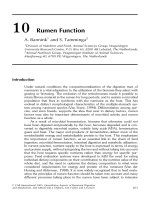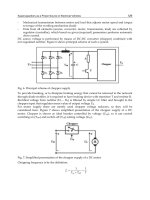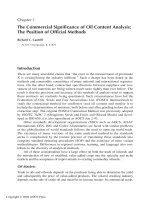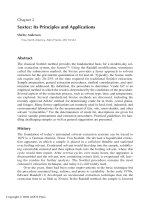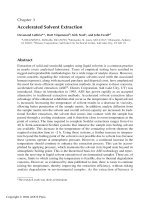oil extraction and analysis phần 8 docx
Bạn đang xem bản rút gọn của tài liệu. Xem và tải ngay bản đầy đủ của tài liệu tại đây (2.68 MB, 15 trang )
Chapter 8
The Rapid Determination of Fat and Moisture in Foods
by Microwave Drying and NMR Analysis
Bobbie McManus and Michelle Horn
CEM Corporation, Matthews, NC 28106–0200
Abstract
Fat and moisture analysis by microwave drying and nuclear magnetic resonance
(NMR) is a direct method that yields accurate results in minutes without solvents
or the frequent calibration required by indirect methods such as near infrared
(NIR) or Fourier transform infrared (FTIR). In the past, NMR was unreliable for
determining fat content in foods because the signal from moisture present in the
sample interfered with the fat reading. There is now a peer-verified, microwave
drying and NMR analysis (AOAC PVM 1:2003) for quantification of the percent-
age of moisture and fat in meat products. The procedure involves determining the
moisture value of meat samples by microwave drying and using the dried sample
to determine the fat value by NMR analysis. Five meat products were analyzed
using a CEM SMART System
TM
(Moisture) and the SMART Trac
TM
System (Fat).
The samples, representing a range of products that meat processors commonly
analyze in daily plant operations, included the following: (i) fresh ground beef,
high fat; (ii) deboned chicken with skins; (iii) fresh pork, low fat; (iv) all beef hot
dogs, and (v) NIST standard reference material samples. The results were com-
pared with moisture and fat values derived from AOAC-approved methods, 950.46
Forced Air Oven Drying and 960.39 Soxhlet Ether Extraction. The chapter also
discusses the analysis of dairy samples by microwave moisture analysis and NMR
fat analysis. These samples include cream, ice cream, and milk with various levels
of fat. Results are compared with the Mojonnier and Gerber techniques.
Introduction
Traditionally, foods have been tested for fat using various wet chemistry methods
that are both time consuming and require more than a passing knowledge of chem-
istry (1). With the introduction of near infrared (NIR) and Fourier transform
infrared (FTIR) instruments, analysis time was reduced to minutes, but the systems
required frequent calibration, a time-consuming and expensive process (2). Fat
determination by use of a combination of microwave drying and NMR analysis
technologies offers the best of both worlds, i.e., the accuracy of traditional wet
chemistry methods and the speed of NIR instruments.
Copyright © 2004 AOCS Press
For many years, laboratories utilized convection or vacuum ovens to dry samples.
Although accurate, this was a time-intensive procedure, often requiring 3–72 h to dry a
sample completely (2). More recently, halogen and infrared moisture analyzers have
reduced drying time to minutes; however, they are not as accurate as traditional oven
methods. Microwave moisture analyzers reduce drying time to minutes, while retain-
ing the accuracy of oven drying. The SMART System
TM
(3), as seen in Figure 8.1,
incorporates a unique octagonal cavity, which focuses the microwaves on the sample,
reducing drying times (Fig. 8.2). It is also the only microwave moisture analyzer that
features a temperature-feedback system, which monitors the temperature of the sample
and adjusts the power as needed to keep the sample from exceeding the user-defined
temperature set point. Additionally, the SMART System (3) continuously monitors
weight loss of the sample during drying to ensure accuracy. Microwave drying has
become the standard in a variety of industries, and many methods have been written
for it by various organizations. The speed and accuracy of microwave drying can
greatly help the quality assurance/quality control (QA/QC) of a company and save
them money by reducing the amount of out-of-specification product. In the 8 h it takes
Fig. 8.1. SMART System
microwave moisture analyzer
(CEM Corporation).
Fig. 8.2. Patented SMART System
octagonal cavity efficiently focus-
es microwave energy to decrease
drying times.
Copyright © 2004 AOCS Press
to conduct a single moisture analysis in a standard drying oven, a company can con-
duct over 120 analyses in a microwave moisture analyzer.
Nuclear magnetic resonance (NMR) imaging is nondestructive and noninvasive,
using a magnet and an electromagnetic coil to force the hydrogen atoms in a substance
to align with the magnetic field (Figs. 8.3 and 8.4). It then sends a pulse of radio-fre-
quency energy through the field, briefly creating a stronger field with which the hydro-
gen atoms align (Fig. 8.5). When the pulse ends, the atoms “relax” back to their origi-
nal alignment and emit a weak electrical signal known as transverse relaxation (T
2
)
decay or free induction decay (FID), which is then measured by the NMR (Fig. 8.6).
Fig. 8.3. A sample is placed in the
magnetic field.
Fig. 8.5. An RF pulse forces atoms
to align temporarily.
Fig. 8.4. Hydrogen atoms align to
the magnetic field.
Fig. 8.6. The atoms “relax” and the
instrument interprets the signal.
Copyright © 2004 AOCS Press
The hydrogen atoms in proteins and carbohydrates relax faster than those in fat; thus,
the instrument can distinguish between the signals to determine the amount of fat in a
substance (4,5).
The term “nuclear” in NMR refers to the instrument's ability to analyze the nuclei
of a sample. (The instrument does not generate any ionizing radiation.) NMR can
cause many nuclei to generate a signal, but most research has been performed on the
detection of signals from the
1
H nucleus, a branch of science commonly known as
“proton NMR.” After a food sample is dried with microwave energy, the remaining
components that contain significant amounts of protons are fats, proteins, and carbohy-
drates, all of which have different transverse relaxation times. The relaxation times for
fats are significantly longer than those of proteins and carbohydrates. Fats typically
have transverse relaxation times of <10 µs or more, whereas proteins and carbohy-
drates demonstrate “solid-like” behaviors and generally have relaxation times ≤10 µs.
Thus, the NMR is able to distinguish between the signals of different components;
after exciting the molecules and letting the “solid-like” signals of protein and carbohy-
drates decay, the remaining signal from the dried sample will be fat.
In the past, NMR was not utilized for determining fat content in many foods
because the signal from moisture present in the sample interfered with the fat reading.
However, by first drying samples using microwave energy, an accurate NMR analysis
can be performed. The SMART Trac
TM
System is a synergy of advanced microwave
drying and NMR technologies that culminates in a truly unique fat analyzer that yields
accurate results in minutes (Fig. 8.7). The SMART Trac is designed to rapidly mea-
sure moisture and fat content in all types of foods in <5 min without solvents, chemi-
cals, or time-intensive maintenance. The system takes a direct measurement of total
fat, including both free and chemically bound fat in solids, liquids, and slurries. The
system is applicable to a full range of food products from low-moisture samples,
including powders and snack foods, to high-moisture samples, such as meat and dairy
products. Unlike wet chemistry methods, the SMART Trac is easy to run and does not
require a knowledge of chemistry. The system measures fat throughout the entire sam-
ple and is not affected by variability in the product (e.g., changes in color, texture, or
composition), whereas NIR and FTIR systems measure fat in only a small portion of
the sample and must be recalibrated when there are changes in the product.
Fig. 8.7. SMART Trac fat
and moisture analyzer
(CEM Corporation).
Copyright © 2004 AOCS Press
Experimentation
After first discussing the equipment, this chapter will describe the methodology for
analysis of a food sample in general and then discuss the specifics of meat and
dairy samples. This new technology for fat analysis has generated a great deal of
interest and there is now a peer-verified, microwave drying and NMR analysis
method (AOAC PVM 1:2003) for the identification of the percentage of moisture
and fat in meat products. The procedure involves determining the moisture value
of meat samples by microwave drying and using the dried sample to determine the
fat value by NMR analysis. The samples, which represent a range of products that
meat processors commonly analyze in daily plant operations, included the follow-
ing: (i) fresh ground beef, high fat; (ii) deboned chicken with skins; (iii) fresh pork,
low fat; (iv) all beef hot dogs; and (v) NIST standard reference material samples.
The results were compared with moisture and fat values derived from AOAC-
approved methods, 950.46 Forced Air Oven Drying and 960.39 Soxhlet Ether
Extraction (2). A method for dairy samples is currently being evaluated by the
AOAC, and approval is expected by mid-2004.
Equipment
The microwave drying/NMR method for this experiment uses a SMART Trac
System comprised of a SMART System
TM
microwave moisture analyzer and a
SMART Trac low-resolution time domain NMR (LR-NMR).
Microwave Moisture Analyzer. The SMART System moisture analyzer features
0.2 mg H
2
O sensitivity, a moisture range of 0.01–99.99% in liquids, solids, and
slurries, 0.01% resolution, and an automatic electronic balance (0.1-mg readabili-
ty). The system has built-in power management and temperature feedback control
for reproducible results. Optimization of power flow into the unique octagonal cav-
ity provides the fastest possible drying times and ensures that high-carbohydrate
samples will not overheat. The system can store 100 methods and up to 300 test
results, as well as perform a statistical analysis of the process including an average
of results, SD, minimum/maximum range, and graphing in reference to target val-
ues.
NMR Processor and Magnet. The SMART Trac NMR Radio Frequency Pulse
Generator uses a pulse power of 250 W nominal, variable pulse times in 100-ns
increments, transmission and reception phases selectable at 0, 90, 180 and 270°C;
and, nominal 90° pulse time of 4 µs (18-mm probe). The magnet is permanent and
thermally stabilized, 0.47 T (20 MHz); homogeneity is better than 10 ppm. Signal
detection is accomplished by dual channel (quadrature) detection with programma-
ble low-pass filtering and a programmable data acquisition rate up to 4 MHz per
pair of points. Figures 8.8–8.10 demonstrate the general method of processing a
sample.
Copyright © 2004 AOCS Press
Meat Applications
Fat is an important component in the meat industry. A less expensive ingredient
than meat, fat adds flavor, but too much of it renders a product extremely difficult
to market in an ever increasingly health conscious society. The SMART Trac
enables manufacturers of meat and meat products to maximize yield and meet
customer expectations, while simultaneously helping to control production costs.
Fig. 8.8. A sample is spread or absorbed
onto a proton-free medium, typically a
glass fiber sample pad, and then continu-
ously weighed while it is dried in the
microwave system at a controlled temper-
ature. It is then cooled to 45°C. Total time
for drying and cooling is 2–3 min.
Fig. 8.10. Because the sample is already
conditioned at a controlled temperature,
the NMR analysis can be immediately
performed, typically requiring <1 min.
Fig. 8.9. The sample is then placed on a
proton-free film (Trac film), rolled up, and
pressed into a Teflon tube for the NMR
analysis.
Copyright © 2004 AOCS Press
Preparation of Meat Samples According to an AOAC-Approved Peer-
Verified Method for the Rapid Determination of Fat and Moisture
To prevent water loss during preparation and subsequent handling, do not use
small samples. Keep ground material in glass or similar containers with air and
watertight covers. Prepare samples for analysis as follows:
1. Collect ~5 pounds of freshly processed product and store at ≤4°C until analyzed.
2. Dice nonground meat product samples into ~2-inch (5.08 cm) cubes and pass
rapidly 2 times through a Hobart grinder (model 4612) or equivalent equipped
with a 3/16 inch (0.1875 inch or 0.4763 cm) plate.
3. Homogenize ground meat products in a Robot Coupe bowl chopper (model R6
or equivalent) to a paste or paté consistency. Place ground material in a chilled
bowl chopper (4°C) and chop for 30 s; scrape down the inner walls and bot-
tom of the bowl with a spatula (plastic or rubber spatula with ~2 × 4 inch
straight-edge blade) and add the material gathered to the body of the test sam-
ple. Repeat the process for an additional 30 s.
4. After homogenization, collect samples and store in plastic containers with
screw cap lids. If the samples are not to be analyzed immediately, store them
at ≤4°C until needed.
Procedure for Fat Determination in a Meat Sample
1. On the SMART System Main Menu screen, select Load Method, then select the
appropriate preprogrammed item to be analyzed, (e.g., ground beef). Note:
Different types of sample matrices and fat will exhibit different responses on the
NMR system. To obtain accurate fat readings, two or more samples of the specif-
ic sample type must be analyzed by the AOAC method. The samples should
cover the entire fat range to be analyzed. Preferably, one high-fat reference sam-
ple and one low-fat reference sample should be analyzed. The reference values
are typed into the SMART Trac system and then replicate runs of each sample
are performed to determine the appropriate NMR signal values for that specific
sample type. After completing the reference scans, the SMART Trac system will
establish a linear relationship for fat determination for that type of sample.
2. Press the Ready Key to initiate the analysis. Place two glass fiber sample pads
(square) in the SMART System Moisture/Solids Analyzer microwave chamber on
the balance and press Tare on the keypad. Tare weight will be automatically
recorded.
3. With a Teflon-coated spatula, transfer ~3–5 g of sample, from the center of the
refrigerated sample container to the center of one of the tared sample pads.
Spread the meat sample evenly across the square pad (see Figs. 8.11 and 8.12).
4. Cover the sample with the other tared square pad as if making a sandwich and
place the pads on the balance in the SMART System Moisture Analyzer.
Copyright © 2004 AOCS Press
5. Dry sample by pressing Start on the keypad. A temperature feedback system
allows rapid temperature measurement of the sample during drying to adjust
the microwave power delivery. Percent Moisture will be displayed on the
screen (± 0.01%) after the sample has dried to a constant weight. Note: Five
short beeps will be heard when drying is complete.
6. Remove pads and roll both in Trac Film (see Figs. 8.13 and 8.14).
7. Compress the rolled sample in the plastic sleeve using the compression tool,
insert sample into the NMR chamber for analysis. [The sample is placed in the
core of an 89-kg magnet and pulsed with radio frequency (RF) energy while in
the static magnetic field. The resulting signal is recorded and analyzed for the
total proton activity of fat present in the sample. Proprietary software analyzes
the NMR data and provides the moisture and fat results.]
8. Press Ready to continue the fat analysis, then press Start to analyze for fat.
Percent Fat will be displayed on the screen (± 0.01%).
Fig. 8.11. If the sample is
in a paste, semisolid, or
crumb form or a raw or
skeletal meat product
such as fresh pork,
ground beef, or chicken,
place the sample on the
end of a spatula and
spread it across one end
of the pad. Then spread
the sample to a uniform
thickness covering ~90%
of the pad surface area.
Fig. 8.12. If the sample
contains bound water
such as an all-meat emul-
sion, cooked all-meat
sausage, sausage with
extenders, semidry
sausage, or ham, place
the sample on the end of
the spatula and apply the
sample to the middle of
the pad. Then spread the
sample around the pad in
a circle.
Copyright © 2004 AOCS Press
Fat and moisture determinations on several different meat products and NIST
standards were performed in laboratories at Texas A&M (TAM) and CEM
Corporation. The results for beef, all beef hot dogs, and chicken are presented in
Tables 8.1, 8.2, and 8.3, respectively.
Fig. 8.13. Place the two square pads and dried sample in the center of the Trac film. Fold
the left corner of the film and pads as illustrated. Fold the right corner. Pull the lower edge
of the film and sample pads toward the top and begin to roll them into a tube.
Fig. 8.14. For samples that are rigid after being dried and more difficult to roll into a
cylinder, prepare the pads as illustrated.
Copyright © 2004 AOCS Press
Dairy Applications
Fat and moisture/solids contents are important components in the dairy industry.
Cream and milk are bought and sold on the basis of the amount of fat they contain.
Because fat is an expensive element in dairy products, it is essential that companies
are certain of the fat content of the cream obtained from their suppliers and that
they tightly control the fat in their products for quality and consistency, cost man-
agement, and regulatory requirements.
Similarly, effective moisture/solids control maximizes yield. Generally, dairies
benefit from controlling solids content in all of their products because moisture, of
course, is a less expensive ingredient than milk solids. Thus, fat and moisture/
TABLE 8.1
AOAC Results from TAM (AOAC Method 950.46 and 960.39) for Fresh Ground,
High-Fat Beef
Weight Moisture Weight Fat
Sample ID (g) (%) (g) (%)
1 4.9750 40.44 3.6150 46.03
2 3.4373 40.42 3.7455 45.86
3 3.7334 40.35 3.8465 45.83
4 3.6018 40.26 3.3339 45.54
5 3.6140 40.49 3.3647 45.92
6 4.2714 40.34 3.6816 45.76
7 3.3022 40.41 3.8443 45.64
8 3.4890 40.44 2.2901 45.92
9 3.2051 40.30 2.2819 45.93
10 3.3612 40.45 2.2736 45.99
Mean 40.39 45.84
SD 0.074 0.157
SMART Trac results from CEM SMART Trac results from TAM
Microwave NMR Microwave NMR
Weight moisture fat Weight moisture fat
Sample ID (g) (%) (%) (g) (%) (%)
1 3.6893 40.19 46.34 3.3149 40.69 45.68
2 3.5562 40.13 46.15 3.8042 40.23 46.25
3 4.1158 40.26 46.08 3.5233 40.18 46.27
4 3.9324 40.20 46.25 3.5591 40.68 45.93
5 4.0714 40.19 46.19 3.9022 40.24 46.24
6 3.8083 40.35 45.99 3.7258 40.32 46.40
7 3.7083 40.44 45.59 3.2478 40.42 45.94
8 3.4759 40.33 45.65 2.9598 40.39 45.92
9 3.4957 40.36 45.50 3.3260 40.42 45.85
10 3.6916 40.32 45.87 3.4150 40.59 45.54
Mean 40.28 45.96 40.42 46.00
SD 0.098 0.295 0.184 0.280
Copyright © 2004 AOCS Press
solids analyses are very beneficial in the production of cheese, milk, sour cream,
ice cream, butter, yogurt, cottage cheese, cream, and other dairy products. The
ability to swiftly adjust their process with the SMART Trac System can save dairy
manufacturers thousands of dollars per year.
Experiment
Dairy samples should be kept in refrigerated storage at ≤4°C in a sealed container
until ready to analyze. The following presents two applications for dairy products
(Table 8.4). They both use the same basic steps in the microwave drying/NMR
analysis. Table 8.5 presents additional dairy sample results for fat analysis by
SMART Trac.
TABLE 8.2
AOAC Results from TAM (AOAC Method 950.46 and 960.39) for All Beef Hot Dogs
Weight Moisture Weight Fat
Sample ID (g) (%) (g) (%)
1 2.4646 51.51 3.2652 30.59
2 2.2422 51.45 3.6297 30.61
3 2.0909 51.64 4.1140 30.44
4 2.0910 51.54 3.1469 30.53
5 2.1961 51.63 3.5239 30.63
6 2.4098 51.75 3.6645 30.36
7 2.2961 51.87 3.4951 30.72
8 2.2859 51.89 3.1308 30.20
9 2.4673 51.80 3.2411 30.54
10 2.0816 51.69 3.1027 30.18
Mean 51.68 30.48
SD 0.152 0.183
SMART Trac results from CEM SMART Trac results from TAM
Microwave NMR Microwave NMR
Weight moisture fat Weight moisture fat
Sample ID (g) (%) (%) (g) (%) (%)
1 4.0588 51.55 30.63 2.5094 51.79 30.30
2 4.3006 51.42 30.64 1.9061 51.96 30.77
3 3.5390 51.64 30.28 2.9303 51.58 30.60
4 4.0012 51.53 30.46 3.2794 51.59 30.29
5 3.6598 51.46 30.65 3.4650 51.97 30.36
6 3.9586 51.47 30.36 3.3049 51.47 30.63
7 4.1737 51.38 30.72 2.8597 51.66 30.45
8 3.6191 51.26 30.57 3.0330 51.97 30.40
9 3.5878 51.44 30.42 2.7080 51.69 30.63
10 3.7391 51.17 30.71 2.7289 51.49 30.71
Mean 51.43 30.54 51.72 30.51
SD 0.138 0.154 0.195 0.175
Copyright © 2004 AOCS Press
1. On the SMART System Main Menu screen, select Load Method, then select
the appropriate preprogrammed item to be analyzed, (e.g., cream). Note:
Different types of sample matrices and fat will exhibit different responses on
the NMR system. To obtain accurate fat readings, two or more samples of the
specific sample type must be analyzed by the AOAC method. The samples
should cover the entire fat range to be analyzed. Preferably, one high-fat refer-
ence sample and one low-fat reference sample should be analyzed. The refer-
ence values are typed into the SMART Trac system and then replicate runs of
each sample are performed to determine the appropriate NMR signal values
for that specific sample type. After completing the reference scans, the
SMART Trac system will establish a linear relationship for fat determination
for that type of sample.
TABLE 8.3
AOAC Results from TAM (AOAC Method 950.46 and 960.39) for Fresh Chicken with Skin
Weight Moisture Weight Fat
Sample ID (g) (%) (g) (%)
1 5.8888 74.52 3.3288 7.36
2 5.9199 74.56 3.4672 7.50
3 6.6851 74.59 3.5339 7.02
4 5.9594 74.55 3.6244 7.49
5 6.2424 74.52 3.4877 7.08
6 6.5156 74.60 3.7604 7.06
7 6.6359 74.60 3.3748 7.16
8 6.2113 74.58 3.5340 7.08
9 6.4292 74.64 3.6059 7.41
10 6.4023 74.56 4.2455 7.20
Mean 74.57 7.24
SD 0.038 0.186
SMART Trac results from CEM SMART Trac results from TAM
Microwave NMR Microwave NMR
Weight moisture fat Weight moisture fat
Sample ID (g) (%) (%) (g) (%) (%)
1 4.0309 74.55 7.25 2.7348 74.28 7.29
2 3.4891 74.51 7.34 3.4454 74.23 7.14
3 3.7672 74.66 7.33 2.6815 74.38 7.22
4 3.4990 74.65 7.32 3.2946 74.18 7.21
5 3.8961 74.53 7.29 3.0128 74.32 7.08
6 3.7438 74.42 7.26 3.6523 74.42 7.16
7 3.7383 74.65 7.24 3.3548 74.55 7.07
8 3.7661 74.25 7.25 4.1013 74.40 7.10
9 3.8905 74.25 7.30 2.8425 74.41 7.07
10 4.1224 74.31 7.27 3.3257 74.54 7.11
Mean 74.48 7.29 74.37 7.15
SD 0.162 0.036 0.121 0.074
Copyright © 2004 AOCS Press
TABLE 8.5
Additional Dairy Sample Results for Fat Analysis by SMART Trac
Reference method SMART Trac
Sample type (% fat) (% fat)
Vanilla ice cream 4.1 4.09
Chocolate ice cream 1.5 1.48
Vanilla ice cream 10 10.06
Chocolate ice cream 9.6 9.62
Chocolate malt 4.1 4.15
Yogurt mix 3.49 3.52
Fat-free chocolate yogurt 0.37 0.35
Reduced-fat milk 1.88 1.89
Fat-free milk 0.05 0.04
Raw milk 4.06 4.04
Raw milk 3.01 3.01
Cheddar cheese 33.2 33.19
Reduced-fat cheddar cheese 20.8 20.85
Nacho cheese 8.1 8.05
Sour cream 17.35 17.4
Light sour cream 8.46 8.52
Fat-free sour cream 2.24 2.21
TABLE 8.4
The Results of Two Applications for Dairy Products
a
Cream Ice cream mix
Sample size (g) 2.0–2.5 1.5–2.0
Power (%) 100 100
Delta weight (mg) 0.2 0.2
Delta time (s) 10 10
Maximum time (min) 5 5
Maximum temperature (°C) 100 100
Weigh compensation On On
Results
Reference method SMART Trac
Sample type (% fat) (% fat)
Ice cream mix 14.38 14.38
Ice cream mix 11.95 11.99
Ice cream mix 5.41 5.4
Cream 42.26 42.21
a
The samples are mixed well; the sample is puddled in the center of the pad and spread with a pipette (Fig. 8.15).
Copyright © 2004 AOCS Press
2. Press the Ready Key to initiate the analysis. Place two glass fiber sample pads
(square) in the SMART System Moisture/Solids Analyzer microwave chamber on
the balance and press Tare on the keypad. Tare weight will be automatically
recorded.
3. With a pipette, transfer ~2–4 g of sample, from the center of the refrigerated
sample container, to the center of one of the tared sample pads. Puddle sample
with a pipette in the center of the square pad (see Fig. 8.15).
4. Cover the sample with the other tared square pad similar to making a sandwich
and place the pads on the balance in the SMART System Moisture Analyzer.
5. Dry sample by pressing Start on the keypad. A temperature feedback system
allows rapid temperature measurement of the sample during drying to adjust
the microwave power delivery. Percent Moisture will be displayed on the
screen (± 0.01%) after the sample has dried to a constant weight. Note: Five
short beeps will be heard when drying is complete.
6. Remove pads and roll both in Trac Film (see Figs. 8.13 and 8.14 in the previous
section).
7. Compress the rolled sample in the plastic sleeve using the compression tool,
and insert the sample into the NMR chamber for analysis. [The sample is
placed in the core of an 89-kg magnet and pulsed with radio frequency (RF)
energy while in the static magnetic field. The resulting signal is recorded and
analyzed for the total proton activity of fat present in the sample. Proprietary
software analyzes the NMR data and provides the moisture and fat results.]
8. Press Ready to continue the fat analysis, then press Start to analyze for fat.
Percent Fat will be displayed on the screen (± 0.01%).
Summary
Fat and moisture determination by microwave drying/NMR analysis is a direct
method that provides accurate results in minutes without the use of hazardous sol-
vents or the frequent calibration required for indirect, rapid methods such as NIR and
FTIR. The easy-to-use SMART Trac System offers a fast alternative to traditional
Fig. 8.15. Spreading technique for liquid samples.
Copyright © 2004 AOCS Press
wet chemistry methods and is equivalent in accuracy. Unlike NIR and FTIR sys-
tems, the SMART Trac does not require frequent calibration and it is not affected
by changes in the composition, color, or texture of the sample. SMART Trac mea-
sures fat protons throughout the sample, not in a small area of the sample as in
indirect methods. With the rapid, accurate results provided by the microwave dry-
ing/NMR fat analysis, companies can optimize their QA/QC process and maximize
their yields in a cost-effective manner.
References
1. Cousins, R., and McManus, B. (2003) CEM Corporation’s SMART Trac
TM
System
Becomes First Peer-Verified Method
SM
of 2003. Inside Laboratory Management, Sept/
Oct: 15–16.
2. Official Methods of Analysis of AOAC International (2000) 17th edn. (Horwitz, W., ed.)
[CD-ROM], AOAC International, Gaithersburg, MD.
3. Keeton, J., Moser, C., and Haire, B., in press, AOAC Peer Review Study: The Rapid
Determination of Moisture and Fat in Meats and Dairy Products by Microwave Drying and
NMR Analysis, Official Methods of Analysis of AOAC International Updates, AOAC
International, Gaithersburg, MD.
4. Macomber, R.S. (1998) A Complete Introduction to Modern NMR Spectroscopy, John
Wiley & Sons, New York.
5. Hore, P.J. (2000) Nuclear Magnetic Resonance, Oxford University Press, New York.
Copyright © 2004 AOCS Press



